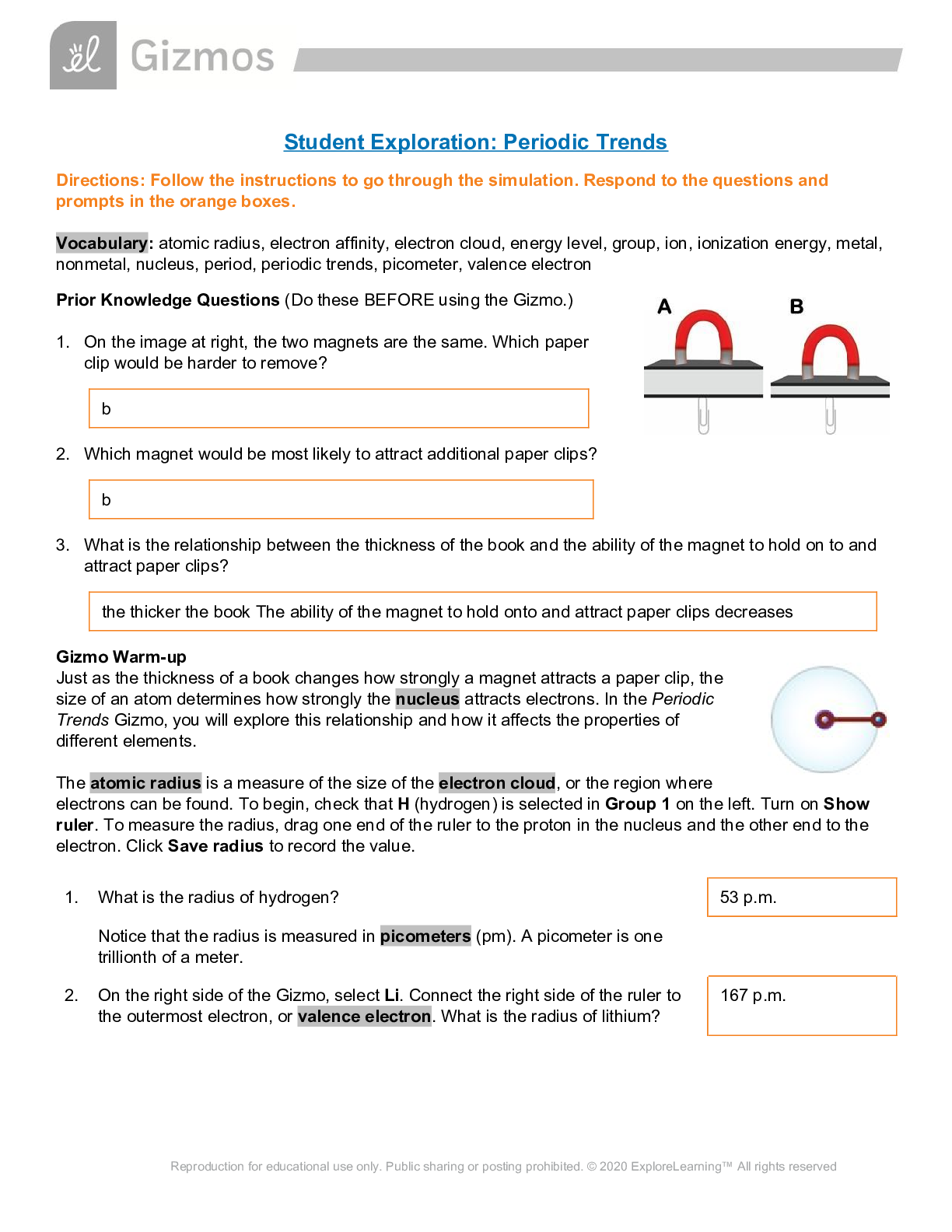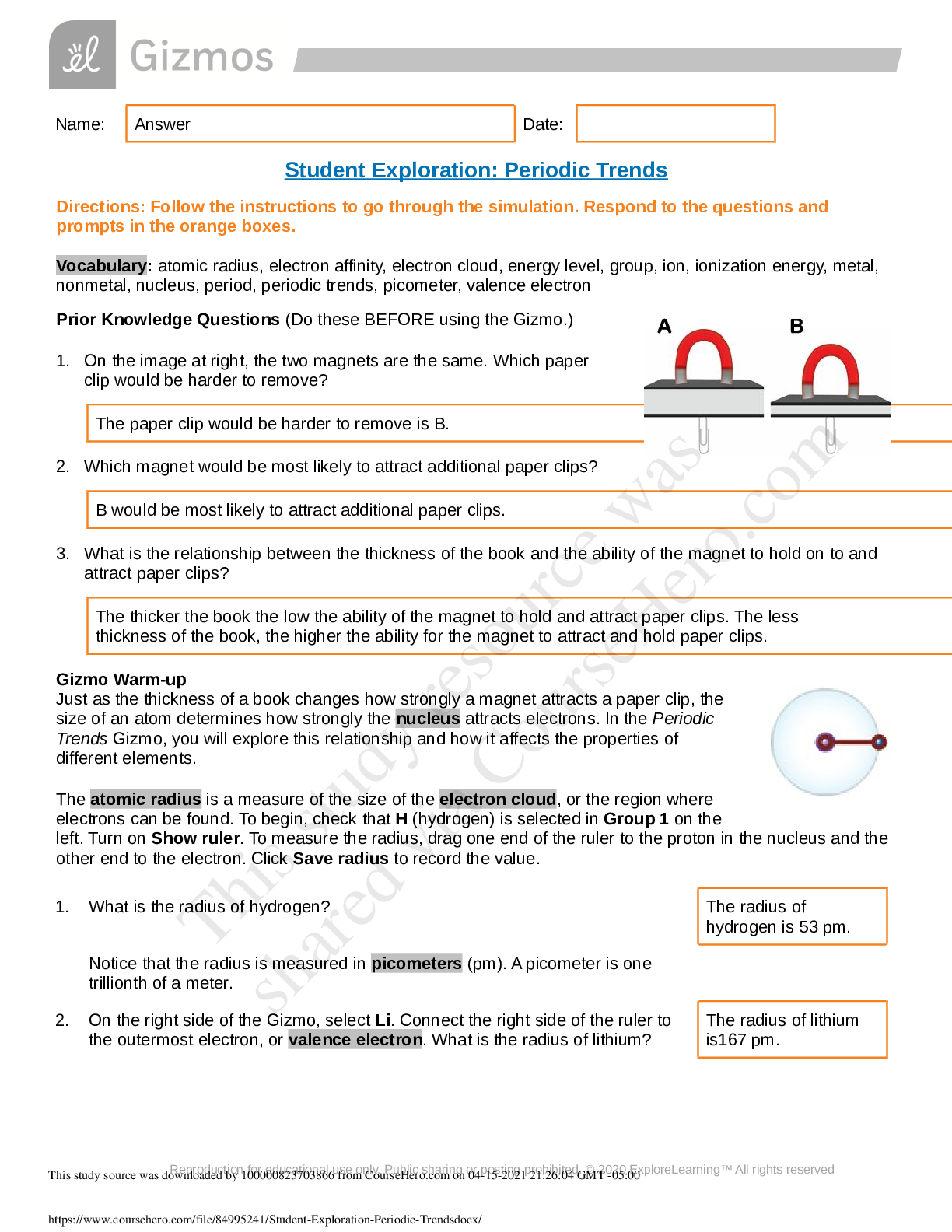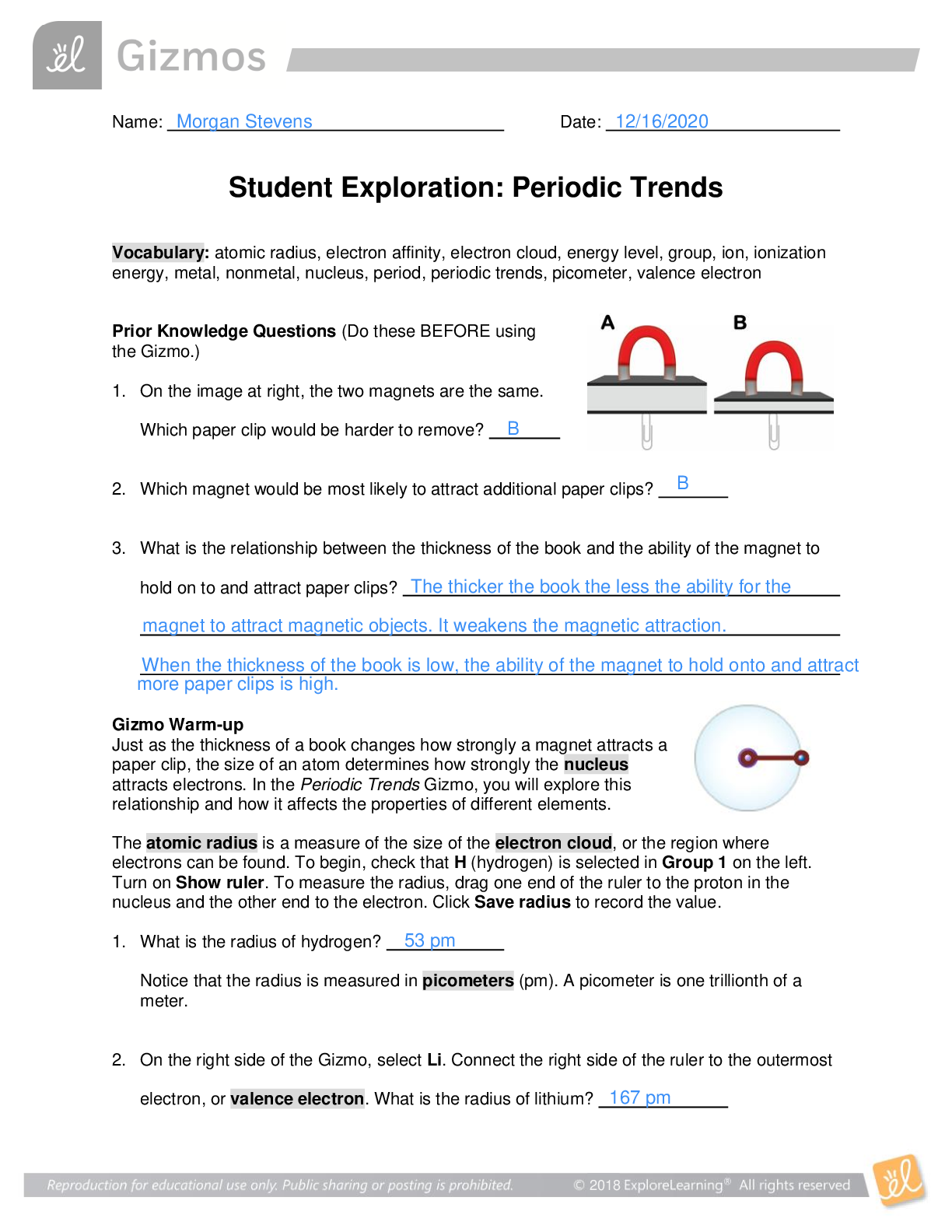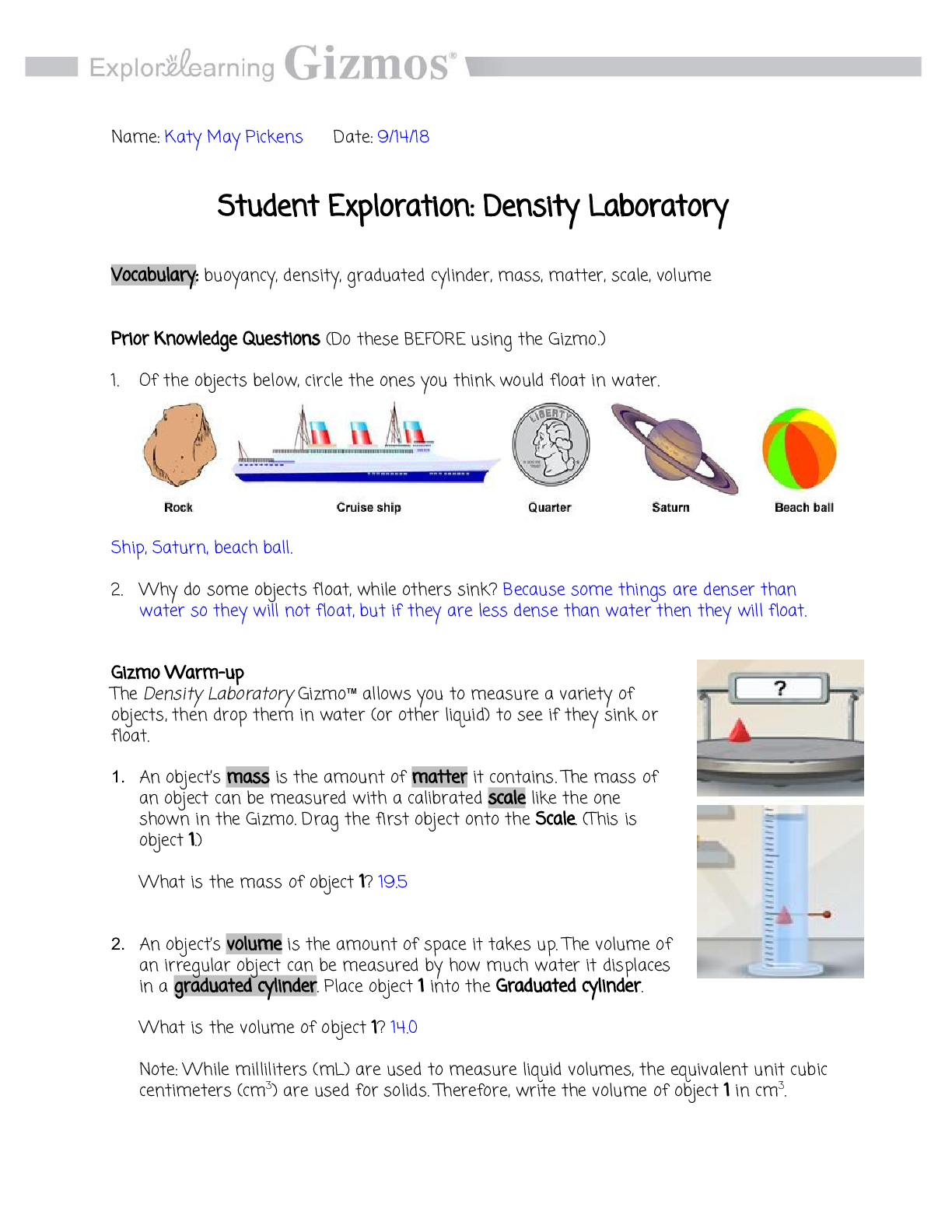GIZMOS. > Student Exploration: Period of a Pendulum. Q&A Score 100%.
Document Content and Description Below
Student Exploration: Period of a Pendulum Directions: Follow the instructions to go through the simulation. Respond to the questions and prompts in the orange boxes. Vocabulary: controlled experime... nt, mean, pendulum, period Prior Knowledge Questions (Do these BEFORE using the Gizmo.) A pendulum is a weight that can swing freely back and forth. The period of a pendulum is the amount of time required to make one full back-and-forth swing. In each of the comparisons below, highlight the pendulum that you think will have a shorter period. Long pendulum vs. Short pendulum Heavy pendulum vs. Light pendulum Pendulum on Earth vs. Pendulum on Moon Pendulum with a large arc vs. Pendulum with a small arc Gizmo Warm-up The Period of a Pendulum Gizmo allows you to explore the factors that control how quickly a pendulum swings back and forth. To begin, practice measuring the period of the pendulum. On the Gizmo, check that all variables are set to their original values: m = 0.5 kg, L = 2.0 m, g = 9.8 m/s2, and θ = 20°. Open the Tools tab and drag an arrow so that it just touches the pendulum at its left-most position, as shown at right. 1. A full “swing” of the pendulum is one complete back-and-forth movement. Select the TABLE tab. Click Mark time each time the pendulum touches the arrow. Mark 10 times. What values do you get for the period of the pendulum? 2. What is the mean of these values? (Note: To find the mean, add up the values and divide by the number of values, or 10.) Reproduction for educational use only. Public sharing or posting prohibited. © 2020 ExploreLearning™ All rights reserved Name: Date: 2.83 Introduction: The Period of a Pendulum Gizmo allows you to investigate four factors: mass (m), length (L), gravitational acceleration (g), and angle (θ). Question: Which factors affect the period of a pendulum? 1. Measure: Click Mark time. Carefully count 10 swings of the pendulum, and click Mark time again at the conclusion of the last swing. 2. Design an experiment: To conduct a fair test of the factors that could affect the period of a pendulum, change only one factor at a time. This is known as a controlled experiment. First, design a controlled experiment to find the effect of mass (m) on period. Describe your experiment below. 3. Gather data: Record the results of your experiment in the table below. 4. Analyze: What was the effect of pendulum mass on the period of the pendulum? Reproduction for educational use only. Public sharing or posting prohibited. © 2020 ExploreLearning™ All rights reserved A. What is the time for 10 swings? B. Divide the time by 10. What is the measured period of the pendulum? C. How does this value compare to the mean period you found in the Gizmo Warm-up? 5. Investigate: Conduct similar controlled experiments on the effects of length, gravitational acceleration, and angle on the pendulum period. Record your results below. Length experiment Gravitation experiment Angle experiment 6. Analyze: Look at your data. A. How did changing the length (L) affect the period? B. How did changing the gravitational acceleration (g) affect the period? C. How did changing the initial angle (θ) affect the period? 7. Compare: How did the results of your experiments compare to the predictions you made in the Prior Knowledge Questions? . Introduction: The Dutch scientist Christiaan Huygens is credited as the first to create a formula that describes the period of a pendulum. In this and the next activity, you will derive Huygens’s formula by measuring the effect of length and gravitation on the period of a pendulum. Question: What is the effect of length on the period of a pendulum? 1. Predict: How do you think a pendulum’s period will change if its length is multiplied by 2? 2. Measure: Keeping g and θ constant, measure the period for each of the following lengths. Leave the last three columns blank for now. Include all units. 3. Calculate: Divide each length by the original length (0.2 m). Record in the “Length factor” column. Fill in the “Time factor” column by dividing each period by the original period. 4. Calculate: Find the square root of each length factor, and fill in the last column of the table. A. What do you notice? B. How does the period of a pendulum relate to the square root of the length factor? 5. Apply: A pendulum with a length of 10 meters has a period of 6.34 seconds. Reproduction for educational use only. Public sharing or posting prohibited. © 2020 ExploreLearning™ All rights reserved A. What is the period of a pendulum with a length of 90 meters? B. What is the period of a pendulum with a length of 160 meters? Question: What is the effect of gravitational acceleration on the period of a pendulum? 2. Measure: Keeping L and θ constant, measure the period for each of the following values of g. Leave the last two columns of the table blank for now. 3. Calculate: Divide each period by the original period, and fill in these values under “Time factor.” Then, take the reciprocal of each of these values, and fill in the last column. 4. Analyze: Compare the value of g to the time factors and reciprocals. 5. Generalize: How does the period relate to the square root of the value of g? Reproduction for educational use only. Public sharing or posting prohibited. © 2020 ExploreLearning™ All rights reserved Activity C: Gravity and period Get the Gizmo ready: ● Click Reset. ● Set L to 1.0 m, g to 1.0 m/s2, and θ to 20°. D. How did the period change when g was multiplied by 4? How did the period change when g was multiplied by 9? In general, what is the relationship between the reciprocal of the time factor and the value of g? 6. Challenge: Put together what you learned in the previous activity and this activity to come up with a formula for the period of a pendulum (T) based on its length and the strength of gravity. The format of the formula is shown below. (Note: In the equation, a is a constant that takes the shape of a pendulum’s arc into account.) Write your formula here: Have your teacher check your formula when it is complete. 7. Measure: Find the period when L is 1.0 m and g is 1.0 m/s2. This is the value of the constant a in your formula. What is the value of a? 8. Apply: Use your formula to find the periods of pendulums with the following parameters. Use the Gizmo to check the first three pendulums. (The Gizmo cannot be used to check the last two sets of parameters.) 9. Think and discuss: The formula you created does not include the initial angle of the pendulum. How do you think the initial angle would affect the formula? Experiment with the Gizmo, and then discuss your results with your classmates and teacher. [Show More]
Last updated: 1 year ago
Preview 1 out of 6 pages

Reviews( 0 )
Recommended For You
Health Care> GIZMOS > GIZMOS Student Exploration: Periodic Trends (All)

GIZMOS Student Exploration: Periodic Trends
GIZMOS Student Exploration: Periodic TrendsGIZMOS Student Exploration: Periodic TrendsGIZMOS Student Exploration: Periodic TrendsGIZMOS Student Exploration: Periodic TrendsGIZMOS Student Exploration:...
By Doctor Immanuel , Uploaded: Apr 28, 2022
$13
Chemistry> GIZMOS > GIZMOS - CHEMISTRY 101: Student Exploration: Periodic Trends Answer Key (100% Correct) A Grade (All)

GIZMOS - CHEMISTRY 101: Student Exploration: Periodic Trends Answer Key (100% Correct) A Grade
Student Exploration: Periodic Trends Directions: Follow the instructions to go through the simulation. Respond to the questions and prompts in the orange boxes. Vocabulary: atomic radius, electron aff...
By jakesuli , Uploaded: Jun 14, 2021
$13
Chemistry> GIZMOS > GIZMOS. CHEMISTRY 101: Student Exploration: Periodic Trends/ Periodic Trends Gizmo. atomic radius, electron affinity, electron cloud, energy level, group, ion, ionization energy, metal, nonmetal, nucleus, period, periodic trends, picometer (All)

GIZMOS. CHEMISTRY 101: Student Exploration: Periodic Trends/ Periodic Trends Gizmo. atomic radius, electron affinity, electron cloud, energy level, group, ion, ionization energy, metal, nonmetal, nucleus, period, periodic trends, picometer
Student Exploration: Periodic Trends Directions: Follow the instructions to go through the simulation. Respond to the questions and prompts in the orange boxes. Vocabulary: atomic radius, electron aff...
By A+ Solutions , Uploaded: May 08, 2021
$12
*NURSING> GIZMOS > Lab Experiment > Student Exploration: Periodic Trends (GIZMOS) (All)

Lab Experiment > Student Exploration: Periodic Trends (GIZMOS)
Lab Experiment > Student Exploration: Periodic Trends (GIZMOS)Lab Experiment > Student Exploration: Periodic Trends (GIZMOS)Lab Experiment > Student Exploration: Periodic Trends (GIZMOS)Lab Experiment...
By VERIFIED A+ , Uploaded: Apr 23, 2021
$0
Chemistry> GIZMOS > GIZMO EXPLORE LEARNING: STUDENT EXPLORATION: PERIODIC TRENDS.LATEST UPDATED DOCUMENT, SATISFACTION AND SUCCESS GUARANTEED (All)

GIZMO EXPLORE LEARNING: STUDENT EXPLORATION: PERIODIC TRENDS.LATEST UPDATED DOCUMENT, SATISFACTION AND SUCCESS GUARANTEED
GIZMO EXPLORE LEARNING: STUDENT EXPLORATION: PERIODIC TRENDS.LATEST UPDATED DOCUMENT, SATISFACTION AND SUCCESS GUARANTEED GIZMO EXPLORE LEARNING: STUDENT EXPLORATION: PERIODIC TRENDS.LATEST UPDATED...
By Quizmaster001 , Uploaded: Apr 16, 2021
$11
Physics> GIZMOS > Lab Experiment > Student Exploration: Periodic Trends (All)

Lab Experiment > Student Exploration: Periodic Trends
Lab Experiment > Student Exploration: Periodic Trends
By quizprof , Uploaded: Mar 10, 2021
$8
Chemistry> GIZMOS > GIZMOS. CHEMISTRY 101: Student Exploration: Periodic Trends/ Periodic Trends Gizmo. atomic radius, electron affinity, electron cloud, energy level, group, ion, ionization energy, metal, nonmetal, nucleus, period, periodic trends, picometer, valence electr (All)

GIZMOS. CHEMISTRY 101: Student Exploration: Periodic Trends/ Periodic Trends Gizmo. atomic radius, electron affinity, electron cloud, energy level, group, ion, ionization energy, metal, nonmetal, nucleus, period, periodic trends, picometer, valence electr
GIZMOS. CHEMISTRY 101: Student Exploration: Periodic Trends/ Periodic Trends Gizmo. atomic radius, electron affinity, electron cloud, energy level, group, ion, ionization energy, metal, nonmetal, nucl...
By kofee , Uploaded: May 15, 2021
$17
Physics> GIZMOS > Student Exploration: Period of a Pendulum - GIZMO Period of a Pendulum - GRADED A+ (2023) (All)

Student Exploration: Period of a Pendulum - GIZMO Period of a Pendulum - GRADED A+ (2023)
Student Exploration: Period of a Pendulum - GIZMO Period of a Pendulum - GRADED A+ (2023)Student Exploration: Period of a Pendulum - GIZMO Period of a Pendulum - GRADED A+ (2023)Student Exploration: P...
By jimmydarts , Uploaded: Jan 07, 2023
$6
Physics> GIZMOS > GIZMOS. > Student Exploration: Period of a Pendulum. Q&A Score 100%. (All)

GIZMOS. > Student Exploration: Period of a Pendulum. Q&A Score 100%.
Student Exploration: Period of a Pendulum Vocabulary: controlled experiment, mean, pendulum, period Prior Knowledge Questions (Do these BEFORE using the Gizmo.) A pendulum is a weight that can swin...
By PAPERS UNLIMITED™ , Uploaded: Jan 15, 2023
$4
Chemistry> GIZMOS > Student Exploration Density Laboratory GIZMOs Answer Key [TOP RATED] (All)

Student Exploration Density Laboratory GIZMOs Answer Key [TOP RATED]
Student Exploration: Density Laboratory Vocabulary: buoyancy, density, graduated cylinder, mass, matter, scale, volume
By jakesuli , Uploaded: Jul 19, 2021
$9
Document information
Connected school, study & course
About the document
Uploaded On
Jan 15, 2023
Number of pages
6
Written in
Additional information
This document has been written for:
Uploaded
Jan 15, 2023
Downloads
0
Views
79






